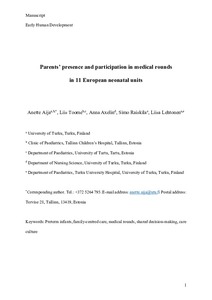Parents’ presence and participation in medical rounds in 11 European neonatal units
Anette Aija; Liis Toome; Anna Axelin; Simo Raiskila; Liisa Lehtonen
https://urn.fi/URN:NBN:fi-fe2021042822844
Tiivistelmä
Background
Parents' involvement during hospital care is beneficial for preterm infants and their parents. Although parents are encouraged to be present in many neonatal intensive care units (NICUs), little is known about their role during medical rounds.
Aims
To study parents' presence in the NICU, the degree of parents' participation during medical rounds, and to identify underlying factors for participation.
Study design and subjects
A prospective study was performed in 11 neonatal units in six European countries including parents of preterm infants born before 35 gestational weeks.
Outcome measures
Parents' presence and the degree of participation (7-point Likert scale) during medical rounds were asked using a text-message question sent to the mobile phone of each parent separately.
Results
A total of 241 families were included in the study; mothers responded to 630 and fathers to 474 text-message questions, respectively. In studied units, mothers were present during medical rounds on 62.5% to 91% and fathers 30.8% to 77.8% of the days. The degree of mothers' and fathers' participation also varied between units (p < 0.001 and p = 0.022, respectively). In multivariate analysis, parents' presence increased by increasing gestational age (p = 0.010), fathers' education (p = 0.009), and by the policy in the unit to invite parents to medical rounds (p = 0.036). The background characteristics did not explain the degree of participation.
Conclusion
There is significant variation between neonatal units in how they include parents in medical rounds. Only few background characteristics explained the differences suggesting that unit culture plays a major role in welcoming parents to participate.
Kokoelmat
- Rinnakkaistallenteet [27094]
